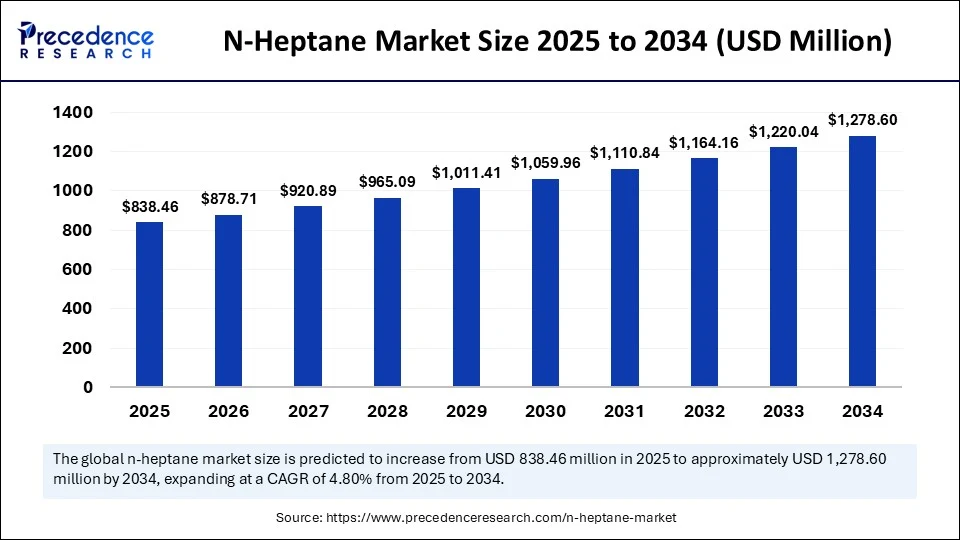The global n-heptane market continues to experience steady expansion, with revenues estimated at USD 800.06 million in 2024 and forecasted to reach USD 1,278.60 million by 2034. This growth is propelled by a compound annual growth rate (CAGR) of 4.80% from 2025 to 2034, reflecting heightened demand for high-purity solvents across key industries including pharmaceuticals, automotive, and electronics.

What Is Driving This Market Growth?
The increasing industrial reliance on n-heptane, particularly as a high-purity solvent, is a top-line driver shaping market dynamics. Pharmaceutical manufacturers require n-heptane for drug formulation and synthesis processes, benefiting from its exceptional solvent properties that ensure chemical purity and efficacy. The automotive sector values n-heptane as a critical component in fuel testing and lubricant formulations, enhancing engine performance standards globally. Additionally, the electronics industry’s growing footprint in Asia Pacific and North America amplifies the demand due to the solvent’s role in manufacturing coatings and adhesives integral to device fabrication.
N-Heptane Market Quick Insights
-
The global n-heptane market was valued at approximately USD 800 million in 2024.
-
It is expected to expand to a market size of USD 1,278.60 million by 2034 at a CAGR of 4.8%.
-
Asia Pacific dominates the market with a valuation of USD 360.03 million in 2024, growing at a CAGR of 4.92%.
-
North America is the fastest-growing region fueled by a robust pharmaceutical and automotive base.
-
The pharmaceutical segment is the top revenue contributor, estimated at USD 39.3 million in 2024 with a growth CAGR of 5.6%.
-
Key players leading the market include companies focusing on advanced purification and high-performance solvent products.
N-Heptane Market Market Revenue Breakdown by Region
| Region | Market Value (USD Million) |
|---|---|
| Asia Pacific | 360.03 |
| North America | Significant and fast-growing (exact value not specified) |
| Europe | Substantial market share |
| Latin America | Emerging growth |
| Middle East & Africa | Moderate growth |
AI’s Role in Revolutionizing the N-Heptane Market
Artificial Intelligence (AI) is transforming n-heptane production and distribution through enhanced process optimization and efficiency. AI-powered systems improve supply chain logistics, packaging, and labeling precision, reducing waste and minimizing production costs by enabling predictive maintenance and yield optimization. Furthermore, AI integration in chemical process enhancements—such as crystallization solvent system optimization involving n-heptane—supports better quality control and bulk density management. In oil and gas applications, AI assists in deposition and asphaltenes destabilization using n-heptane, showcasing its potential to refine industrial processes and uplift product consistency.
Which Factors Are Accelerating Market Expansion?
Several factors contribute to the positive outlook for the n-heptane market. The growing pharmaceutical industry’s demand for ultra-pure solvents fosters continual market expansion. Industrialization and rapid urbanization in Asia Pacific, particularly in China, India, and Japan, fuel the need for n-heptane in diverse sectors from chemical manufacturing to automotive coatings. Increasing environmental regulations encourage the adoption of n-heptane owing to its relatively low aromatic content and role in reducing VOC emissions compared to traditional solvents. Additionally, technological advancements in refining and purification methods bolster product quality and widen application scopes.
What Are the Market Opportunities and Emerging Trends?
How is the shift toward sustainability impacting the n-heptane market? Could bio-based n-heptane become a new growth avenue?
Sustainability drives innovation in solvent production, with increasing research into bio-based n-heptane varieties that align with environmental regulations and global green chemistry initiatives. The expansion of industries such as automotive manufacturing, pharmaceuticals, and electronics in emerging economies presents ample opportunity for n-heptane demand growth. The market is also witnessing a trend toward higher purity grades (>99%) to meet stringent industrial and regulatory standards. This underlines a shift to more specialized and value-added applications requiring premium solvent quality.
N-Heptane Market Segmentation Analysis
The n-heptane market is categorized by purity levels: below 95%, 95-99%, and above 99%, with the highest purity segment showing the most rapid growth due to its adoption in precision-driven sectors like pharmaceuticals and electronics. Application-wise, pharmaceutical uses dominate, followed by electronics, adhesives and sealants, plastics and polymers, automotive manufacturing, coatings, paints, and specialty chemical processing. Regionally, Asia Pacific leads by market share and growth due to large-scale industrial activities, followed by North America with its sophisticated pharmaceutical and automotive industries. Europe maintains a solid presence focused on quality and environmental regulations.
Latest Breakthroughs and Industry Leaders
Companies operating in the n-heptane market have recently advanced purification technologies, improving solvent quality and consistency crucial for high-performance applications. Innovations include AI-assisted crystallization and solvent blend optimizations enhancing yield and reducing waste. Strategic partnerships among industrial players, particularly in Asia, have enhanced supply chain resilience and product development efforts. Leading companies pursuing these innovations help drive market competitiveness and address environmental sustainability requirements.
Key industry contributors include major chemical manufacturers and solvent producers committed to high-purity n-heptane production and application development.
N-Heptane Market Market Challenges and Cost Pressures
The n-heptane market faces challenges from fluctuating crude oil prices impacting production costs and pricing strategies. Strict environmental regulations on VOC emissions require manufacturers to adopt costly compliance measures, influencing profitability. Competition from alternative eco-friendly solvents also poses a threat to market share. Supply chain bottlenecks linked to raw material availability in some regions have the potential to disrupt distribution. Lastly, limited awareness of n-heptane’s diverse applications in emerging markets curtails adoption and limits growth potential.
Case Study Highlight: Pharmaceutical Solvent Efficiency Improvement Using AI
A leading pharmaceutical firm integrated AI-driven optimization to tailor their n-heptane solvent purification, leading to a 15% increase in yield consistency and a 10% reduction in solvent waste during drug synthesis. This innovation resulted in faster compliance with quality standards and reduced manufacturing costs, illustrating the convergence of AI technology and chemical production for enhanced market value.
Read Also: Sodium Tetraborate Market
You can place an order or ask any questions, please feel free to contact us at sales@precedenceresearch.com |+1 804 441 9344